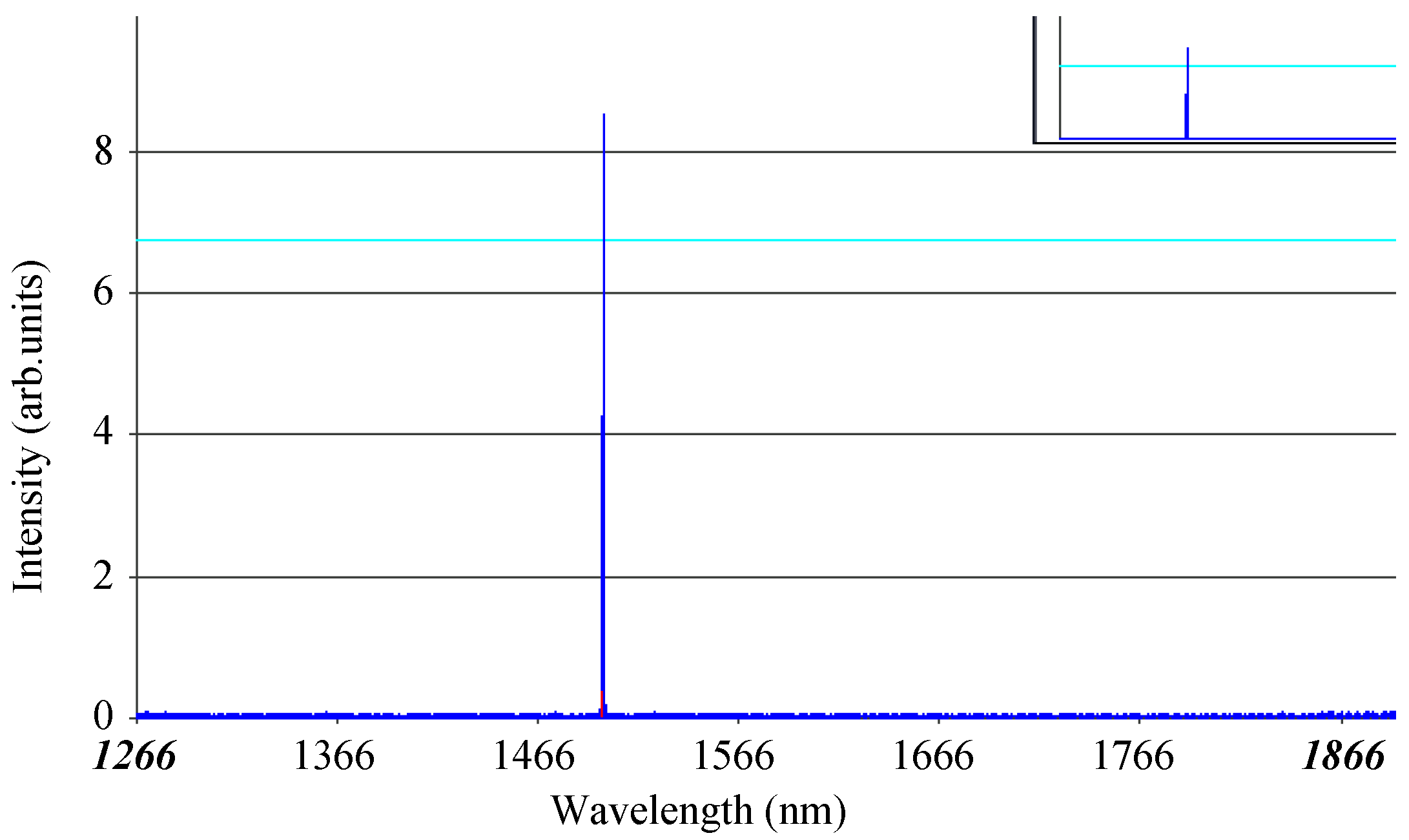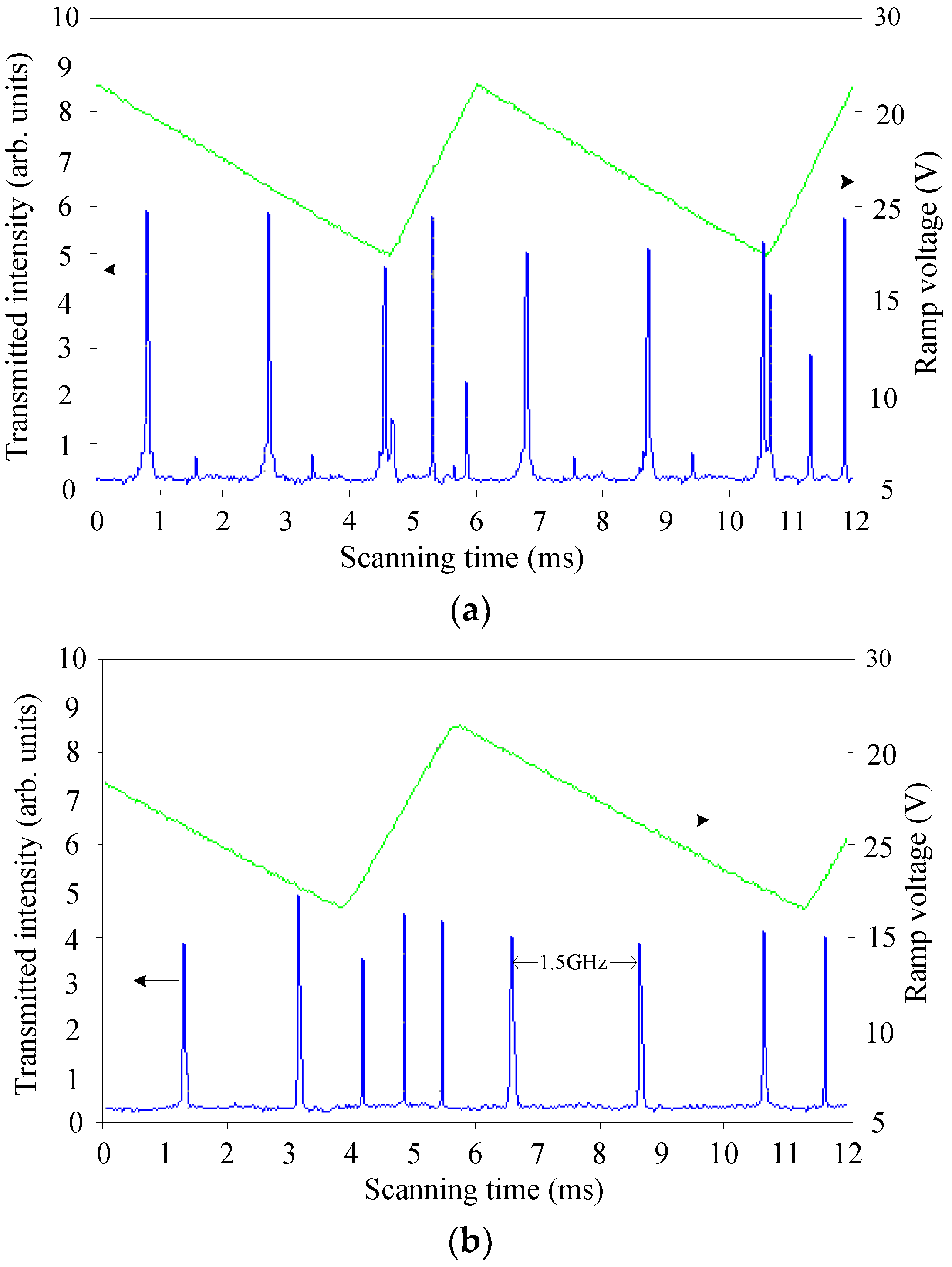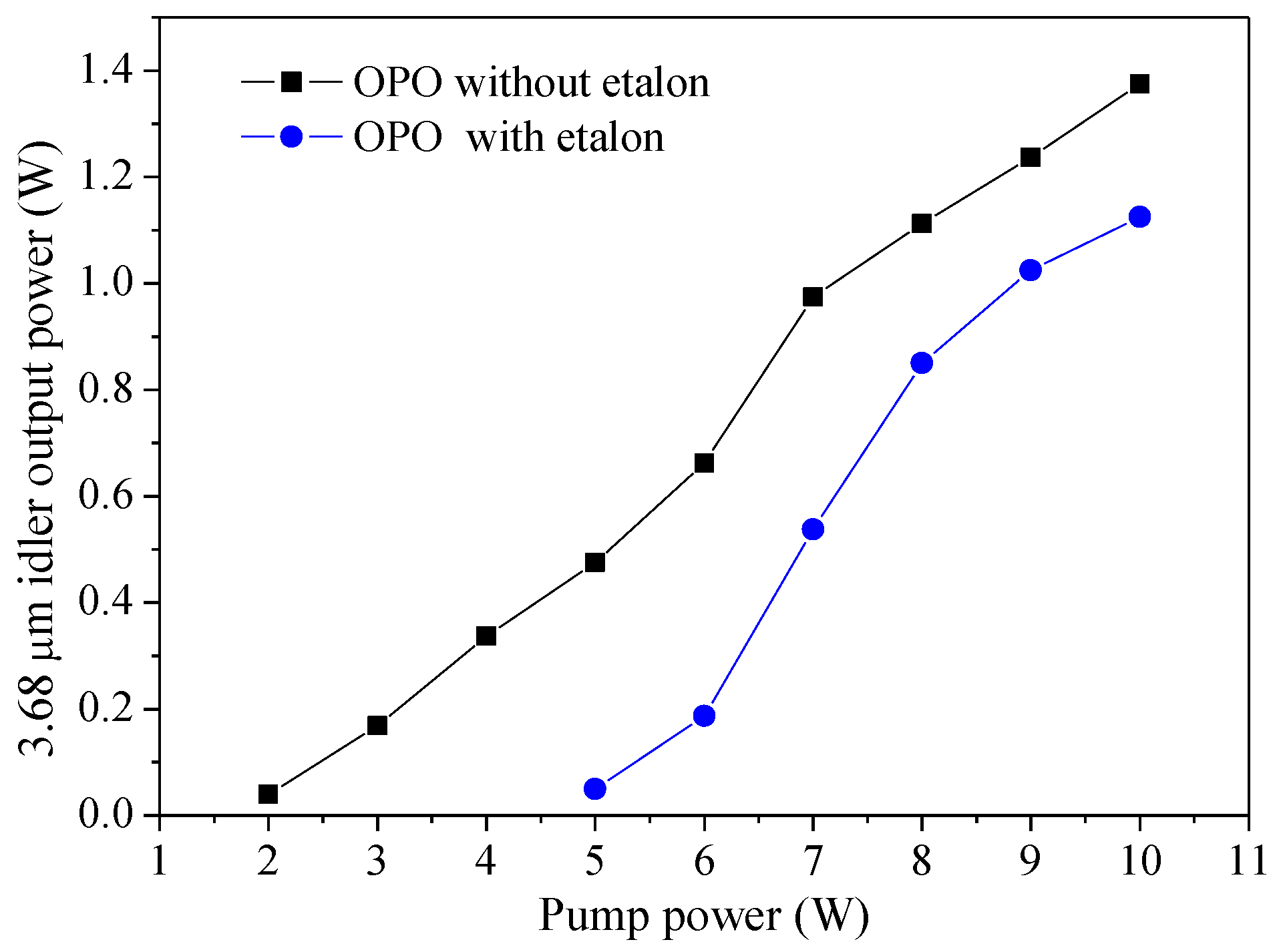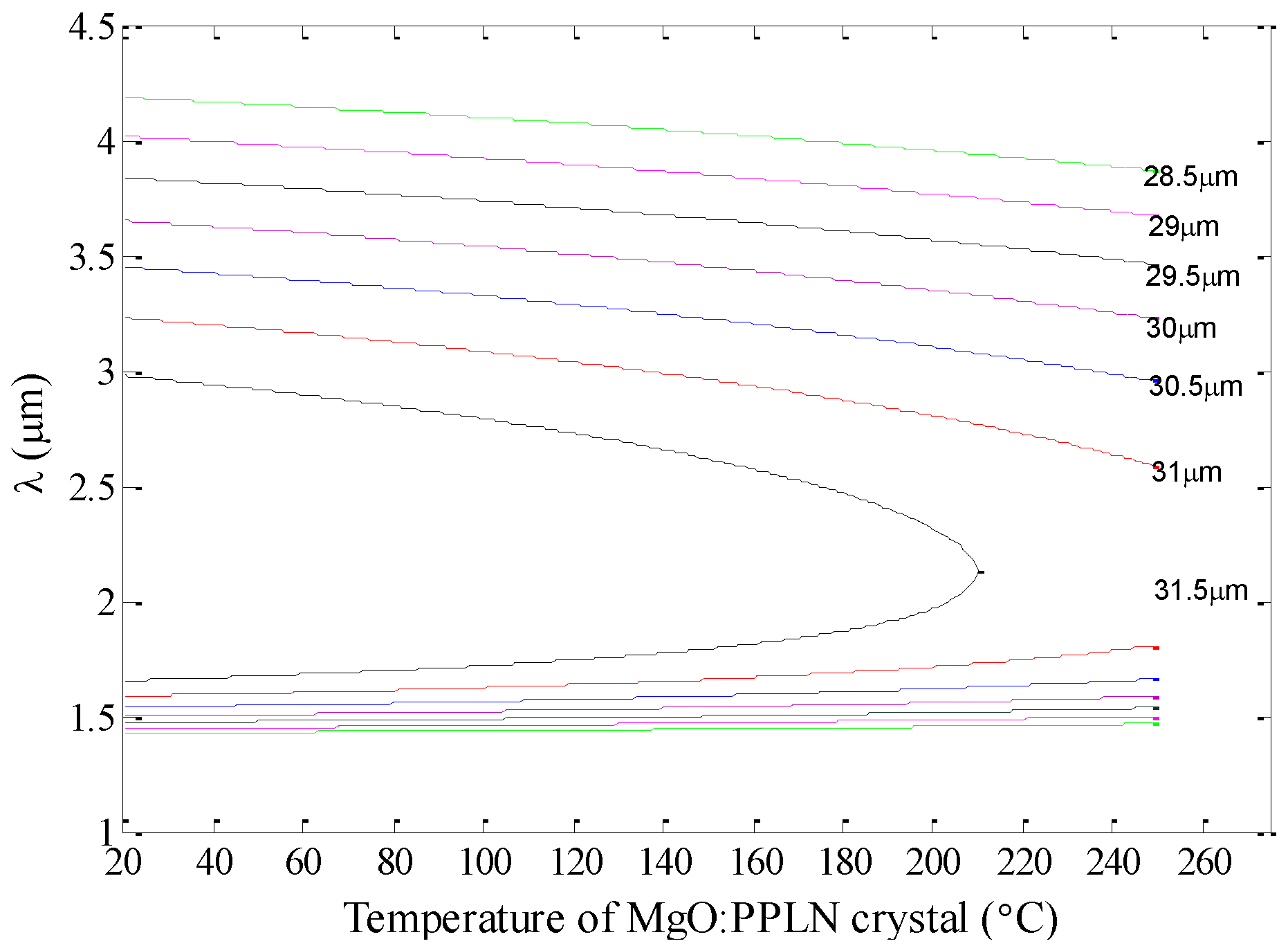Watt-Level Continuous-Wave Single-Frequency Mid-Infrared Optical Parametric Oscillator Based on MgO:PPLN at 3.68 µm
Abstract
:1. Introduction
2. Experimental Setup
3. Experimental Results and Discussion
4. Conclusions
Author Contributions
Funding
Acknowledgments
Conflicts of Interest
References
- Kovalchuk, E.V.; Dekorsy, D.; Lvovsky, A.I.; Braxmaier, C.; Mlynek, J.; Peters, A.; Schiller, S. High-resolution Doppler-free molecular spectroscopy with a continuous-wave optical parametric oscillator. Opt. Lett. 2001, 26, 1430–1432. [Google Scholar] [CrossRef] [PubMed]
- Verbraak, H.; Ngai, A.K.Y.; Persijn, S.T.; Harren, F.J.M.; Linnartz, H. Mid-infrared continuous wave cavity ring down spectroscopy of molecular ions using an optical parametric oscillator. Chem. Phys. Lett. 2007, 442, 145–149. [Google Scholar] [CrossRef] [Green Version]
- Zaske, S.; Lee, D.-H.; Becher, C. Green-pumped cw singly resonant optical parametric oscillator based on MgO:PPLN with frequency stabilization to an atomic resonance. Appl. Phys. B 2010, 98, 729–735. [Google Scholar] [CrossRef]
- Ricciardi, I.; Tommasi, E.D.; Maddaloni, P.; Mosca, S.; Rocco, A.; Zondy, J.J.; Natale, P.D. A narrow-bandwidth, frequency-stabilized OPO for sub-Doppler molecular spectroscopy around 3 μm. Proc. SPIE 2012, 8434, 84341Z. [Google Scholar]
- Mickelson, P.G.; Martinez de Escobar, Y.N.; Anzel, P.; De Salvo, B.J.; Nagel, S.B.; Traverso, A.J.; Yan, M.; Killian, T.C. Repumping and spectroscopy of laser-cooled Sr atoms using the (5s5p)3P2-(5s4d)3D2 transition. J. Phys. B Mol. Opt. Phys. 2009, 42, 235001. [Google Scholar] [CrossRef]
- Bandyopadhyay, N.; Slivken, S.; Bai, Y.; Razeghi, M. High power, continuous wave, room temperature operation of λ~3.4 μm and λ~3.55 μm InP-based quantum cascade lasers. Appl. Phys. Lett. 2012, 100, 212104–212107. [Google Scholar] [CrossRef]
- Razeghi, M. High-performance InP-based mid-IR quantum cascade lasers. IEEE J. Sel. Top. Quantum Electron. 2009, 15, 941–951. [Google Scholar] [CrossRef]
- Jelínková, H.; Němec, M.; Šulc, J.; Miyagi, M.; Iwai, K.; Takaku, H.; Doroshenko, M.; Basiev, T.T.; Komar, V.K.; Gerasimenko, A.S. Transfer of Fe:ZnSe laser radiation by hollow waveguide. Laser Phys. Lett. 2011, 8, 613–616. [Google Scholar] [CrossRef]
- Evans, J.W.; Berry, P.A.; Schepler, K.L. 840 mW continuous-wave Fe:ZnSe laser operating at 4140 nm. Opt. Lett. 2012, 37, 5021–5023. [Google Scholar] [CrossRef] [PubMed]
- Murray, R.T.; Runcorn, T.H.; Guha, S.; Taylor, J.R. High average power parametric wavelength conversion at 3.31–3.48 μm in MgO:PPLN. Opt. Express 2017, 25, 6421–6430. [Google Scholar] [CrossRef] [PubMed]
- Kemlin, V.; Jegouso, D.; Debray, J.; Segonds, P.; Boulanger, B.; Menaert, B.; Ishizuki, H.; Taira, T. Widely tunable optical parametric oscillator in a 5 mm thick 5% MgO:PPLN partial cylinder. Opt. Lett. 2013, 38, 860–862. [Google Scholar] [CrossRef] [PubMed]
- Zhao, J.Q.; Yao, B.Q.; Zhang, X.L.; Li, L.; Ju, Y.L.; Wang, Y.Z. An efficient, compact intra-cavity continuous-wave mid-infrared SRO with a narrow line width. Laser Phys. Lett. 2013, 10, 045801. [Google Scholar] [CrossRef]
- Wei, X.; Peng, Y.; Wang, W.; Chen, X.; Li, D. High-efficiency mid-infrared laser from synchronous optical parametric oscillation and amplification based on a single MgO:PPLN crystal. Appl. Phys. B 2011, 104, 597–601. [Google Scholar] [CrossRef]
- Koch, P.; Ruebel, F.; Nittman, M.; Bauer, T.; Bartschke, J.; L’huillier, J.A. Narrow-band, tunable 2 μm optical parametric oscillator based on MgO:PPLN at degeneracy with a volume Bragg grating output coupler. Appl. Phys. B 2011, 105, 715–720. [Google Scholar] [CrossRef]
- Das, R.; Kumar, S.C.; Samanta, G.K.; Ebrahim-Zadeh, M. Broadband, high-power, continuous-wave, mid-infrared source using extended phase-matching bandwidth in MgO:PPLN. Opt. Lett. 2009, 34, 3836–3838. [Google Scholar] [CrossRef] [PubMed]
- Peng, Y.F.; Wei, X.B.; Xie, G.; Gao, J.R.; Li, D.M.; Wang, W.M. A high-power narrow-linewidth optical parametric oscillator based on PPMgLN. Laser Phys. 2013, 23, 055405. [Google Scholar] [CrossRef]
- Henderson, A.; Stafford, R. Low threshold, singly-resonant CW OPO pumped by an all-fiber pump source. Opt. Express 2006, 14, 767–772. [Google Scholar] [CrossRef] [PubMed]
- Vainio, M.; Peltola, J.; Persijn, S.; Harren, F.J.; Halonen, L. Singly resonant cw OPO with simple wavelength tuning. Opt. Express 2008, 16, 11141–11146. [Google Scholar] [CrossRef] [PubMed]
- Zeil, P.; Thilmann, N.; Pasiskevicius, V.; Laurell, F. High-power, single-frequency, continuous-wave optical parametric oscillator employing a variable reflectivity volume Bragg grating. Opt. Express 2014, 22, 29907–29913. [Google Scholar] [CrossRef] [PubMed]
- Xing, T.; Wang, L.; Hu, S.; Cheng, T.; Wu, X.; Jiang, H. Widely tunable and narrow-bandwidth pulsed mid-IR PPMgLN-OPO by self-seeding dual etalon-coupled cavities. Opt. Express 2017, 25, 31810–31815. [Google Scholar] [CrossRef] [PubMed]
- Zhao, J.Q.; Wang, Y.Z.; Yao, B.Q.; Ju, Y.L. High efficiency, single-frequency continuous wave Nd:YVO4/YVO4 ring laser. Laser Phys. Lett. 2010, 7, 135–138. [Google Scholar] [CrossRef]
- Gayer, O.; Sacks, Z.; Galun, E.; Arie, A. Temperature and Wavelength Dependent Refractive Index Equations for MgO-doped Congruent and Stoichiometric LiNbO3. Appl. Phys. B 2008, 91, 343–348. [Google Scholar] [CrossRef]






© 2018 by the authors. Licensee MDPI, Basel, Switzerland. This article is an open access article distributed under the terms and conditions of the Creative Commons Attribution (CC BY) license (http://creativecommons.org/licenses/by/4.0/).
Share and Cite
Zhao, J.; Cheng, P.; Xu, F.; Zhou, X.; Tang, J.; Liu, Y.; Wang, G. Watt-Level Continuous-Wave Single-Frequency Mid-Infrared Optical Parametric Oscillator Based on MgO:PPLN at 3.68 µm. Appl. Sci. 2018, 8, 1345. https://doi.org/10.3390/app8081345
Zhao J, Cheng P, Xu F, Zhou X, Tang J, Liu Y, Wang G. Watt-Level Continuous-Wave Single-Frequency Mid-Infrared Optical Parametric Oscillator Based on MgO:PPLN at 3.68 µm. Applied Sciences. 2018; 8(8):1345. https://doi.org/10.3390/app8081345
Chicago/Turabian StyleZhao, Jiaqun, Ping Cheng, Feng Xu, Xiaofeng Zhou, Jun Tang, Yong Liu, and Guodong Wang. 2018. "Watt-Level Continuous-Wave Single-Frequency Mid-Infrared Optical Parametric Oscillator Based on MgO:PPLN at 3.68 µm" Applied Sciences 8, no. 8: 1345. https://doi.org/10.3390/app8081345



